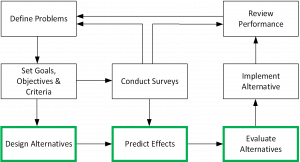2.2.4 Selection Process
Course subject(s)
Module 2. System approach to understand city logistics
The selection process consists of three steps: Designing Alternatives, Predicting the Effects and Evaluating Alternatives.
Designing Alternatives
Designing alternatives involves identifying potential solutions for the problems identified that offer possible means of for accomplishing the aims and objectives. Alternatives are restricted by constraints, since nearly all options involve some investment of resources. Identification of new or innovative alternatives often involves lateral thinking and being creative (eg. brainstorming sessions). For example, solutions can involve new technology, operations, construction or regulations. Alternatives will typically require financial, physical and human resources. Often the range of alternatives will be constrained by financial, legal, social or political issues.
Examples of innovative solutions to urban distribution problems include, urban consolidation centres (Figure 3) and off-peak deliveries (Figure 4). These will be described in more detail in module 4.

Figure 3 Urban Consolidation Centre (Source: Urban consolidation centre by Tharsis )

Figure 4 Off Hour Deliveries (Source: Photo by Israel Sundseth on Unsplash)
Predicting the Effects
Procedures are required to predict the performance of alternatives. Models are abstract representations of the real world. Common types of freight models are demand (flow of goods), supply (performance of the system) and impacts (economic, social and environmental). They are commonly used to predict the consequences of alternatives before implementation. Models are generally mathematical, computer simulation or econometric, usually formulated in either, conceptual, physical or mathematical terms. Intuition based on judgement and or experience is an informal type of personal model. It is often necessary to conduct sensitivity analysis to investigate the variability of the predicted effects of the alternatives with respect to the assumptions made within the models. It is common to consider the effects of varying a number of parameters including, demand growth rates, life of the project as well as operation and maintenance costs.
Evaluating Alternatives
Evaluation involves the methodical comparison of alternatives, based on an assessment of the predicted consequences or impacts of alternatives. Consequences stem from the operation of the freight system, including the effects of resource consumption and the impacts of system outputs on its immediate environment. Impacts can be broadly classified as either economic, social or environmental. There are usually significant trade-offs of the impacts between within these three areas. Finding an alternative that balances the economic, social and environmental impacts is a major challenge in most urban freight systems. Major issues that typically need to be addressed relate to the feasibility (engineering) and acceptability of the impacts of alternatives as well as assessing the likelihood of alternatives in attaining the goals and objectives of the system.

Sustainable Urban Freight Transport: a Global Perspecitive by TU Delft OpenCourseWare is licensed under a Creative Commons Attribution-NonCommercial-ShareAlike 4.0 International License.
Based on a work at https://ocw.tudelft.nl/courses/sustainable-urban-freight-transport-global-perspective/.




